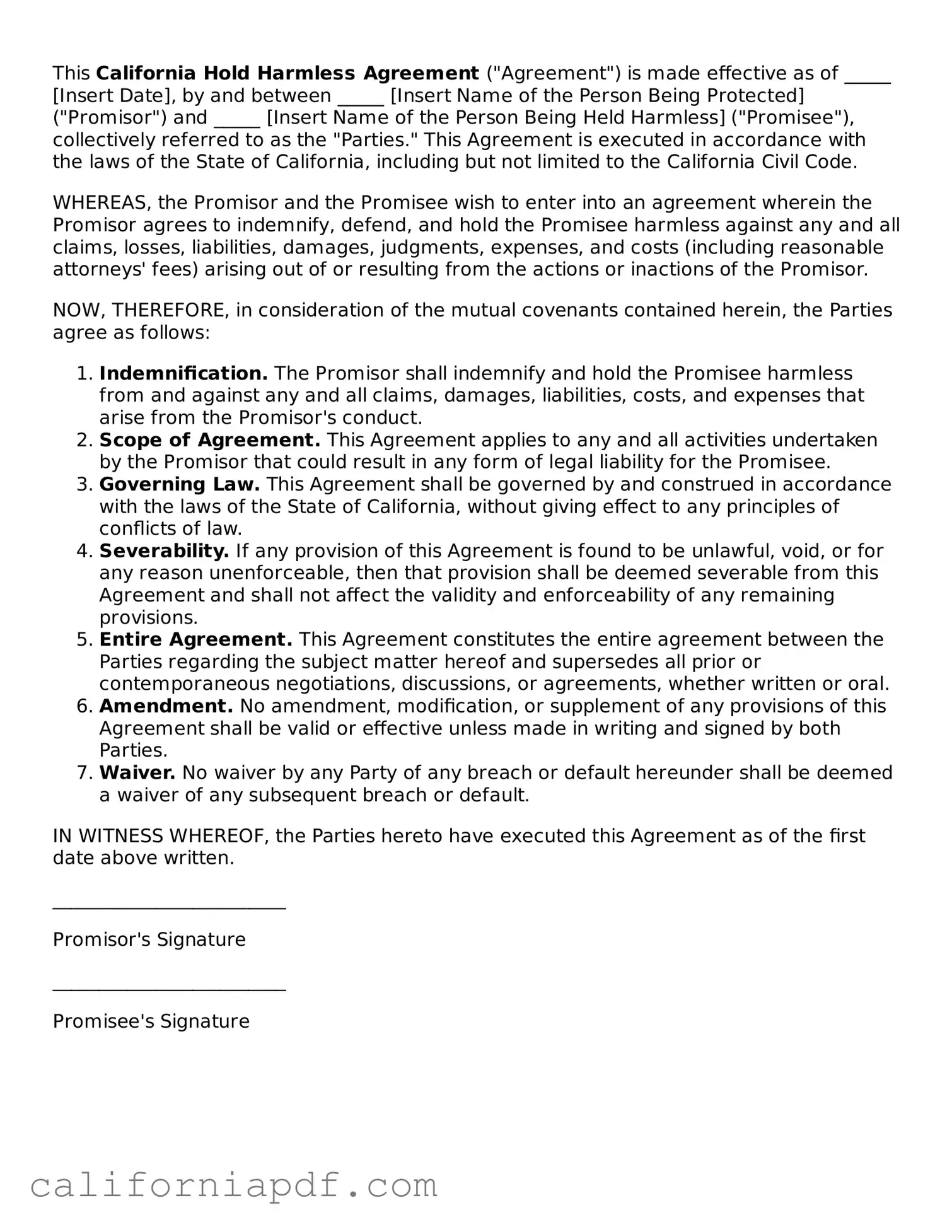The California Hold Harmless Agreement form shares a common objective with an Indemnity Agreement. Both documents are designed to protect one party from legal claims or liabilities that may arise from a particular action or event. An Indemnity Agreement specifically obligates one party to compensate the other for any losses or damages incurred, mirroring the protective essence of a Hold Harmless Agreement but with a broader application across various scenarios beyond the scope of physical harm or property damage.
Similar to the Hold Harmless Agreement, a Waiver of Liability also plays a pivotal role in preventing legal actions from being taken against a party, typically in situations where an individual voluntarily participates in potentially risky activities. This document ensures that participants acknowledge and accept the inherent risks, thus protecting hosts or organizers from lawsuits. The key similarity lies in the waiver's primary function to shield the party requesting the waiver from legal claims, akin to the protective measure provided by the Hold Harmless Agreement.
A Release of Liability is akin to the Hold Harmless Agreement, with both serving the purpose of releasing one party from legal claims by another. However, the Release of Liability is often used after an incident has occurred, facilitating the settlement of potential claims without litigation. It’s a mutual agreement that a matter will not progress to a legal dispute, offering closure on potential claims in exchange for compensation or other terms agreed upon by the parties involved.
Non-Disclosure Agreements (NDAs) share the similarity of creating binding obligations between parties, much like Hold Harmless Agreements. While NDAs focus on the confidentiality and non-use of proprietary information, Hold Harmless Agreements focus on liability and risk mitigation. Both types of documents ensure that the signees adhere to specific conditions, failing which legal remedies can be sought by the aggrieved party, thereby providing a protective legal framework tailored to different needs.
Service-Level Agreements (SLAs) bear similarities to Hold Harmless Agreements in terms of specifying parties' obligations and ensuring protections. SLAs outline the level of service expected from a service provider, including response times and quality benchmarks, offering recourse in the event of non-compliance. Though SLAs are more specific to service delivery standards, both document types are integral in setting clear expectations and accountability measures between parties.
Property Leases and Hold Harmless Agreements both include clauses that protect one of the involved parties from certain liabilities. In a Property Lease, this often pertains to conditions under which the landlord or the tenant is not responsible for damages or injuries. Hold Harmless Agreements extend this concept by ensuring one party is not held liable for certain incidents, making both documents crucial in managing risk and legal responsibility in their respective contexts.
Employment Contracts, while primarily outlining the terms of employment, compensation, and duties, can incorporate clauses similar to those found in Hold Harmless Agreements. These clauses might protect the employer from liabilities arising from the actions of the employee during the course of their employment. Such provisions protect the business from potential legal complications related to their employees' conduct, spotlighting the preventative legal strategy both document types employ.
Joint Venture Agreements, establishing the terms under which parties agree to undertake a business project together, often contain clauses that shield parties from certain liabilities, akin to a Hold Harmless Agreement. These provisions are critical in defining how liabilities and responsibilities are shared or segregated among the participants, ensuring that each party is aware of their protections and obligations in the venture's operation.
Lastly, Membership Agreements, especially in the context of health clubs or online platforms, share characteristics with Hold Harmless Agreements by incorporating terms that limit the operator's liability for incidents or injuries that occur during the use of services or participation in the activities sponsored by the organization. Such clauses help in managing the risks associated with offering these services or activities, ensuring members participate at their own risk.
